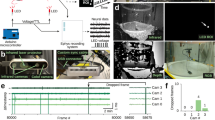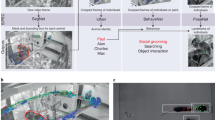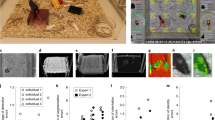Abstract
The study of social interactions in mice is used as a model for normal and pathological cognitive and emotional processes. But extracting comprehensive behavioral information from videos of interacting mice is still a challenge. We describe a computerized method and software, MiceProfiler, that uses geometrical primitives to model and track two mice without requiring any specific tagging. The program monitors a comprehensive repertoire of behavioral states and their temporal evolution, allowing the identification of key elements that trigger social contact. Using MiceProfiler we studied the role of neuronal nicotinic receptors in the establishment of social interactions and risk-prone postures. We found that the duration and type of social interactions with a conspecific evolves differently over time in mice lacking neuronal nicotinic receptors (Chrnb2−/−, here called β2−/−), compared to C57BL/6J mice, and identified a new type of coordinated posture, called back-to-back posture, that we rarely observed in β2−/− mice.
This is a preview of subscription content, access via your institution
Access options
Subscribe to this journal
Receive 12 print issues and online access
$259.00 per year
only $21.58 per issue
Buy this article
- Purchase on Springer Link
- Instant access to full article PDF
Prices may be subject to local taxes which are calculated during checkout






Similar content being viewed by others
References
Robbins, T.W. & Arnsten, A.F. The neuropsychopharmacology of fronto-executive function: monoaminergic modulation. Annu. Rev. Neurosci. 32, 267–287 (2009).
Chandler, R.A., Wakeley, J., Goodwin, G.M. & Rogers, R.D. Altered risk-aversion and risk-seeking behavior in bipolar disorder. Biol. Psychiatry 66, 840–846 (2009).
Baker, M. Inside the minds of mice and men. Nature 475, 123–128 (2011).
Blanchard, D.C., Griebel, G. & Blanchard, R.J. The mouse defense test battery: pharmacological and behavioral assays for anxiety and panic. Eur. J. Pharmacol. 28, 97–116 (2003).
Crawley, J.N. Mouse behavioral assays relevant to the symptoms of autism. Brain Pathol. 17, 448–459 (2007).
Panksepp, J., Siviy, S. & Normansell, L. The psychobiology of play: theoretical and methodological perspectives. Neurosci. Biobehav. Rev. 8, 465–492 (1984).
Insel, T.R. Mouse models of autism: report from a meeting. Mamm. Genome 12, 755–757 (2001).
Metaxas, D. & Terzopoulos, D. Shape and nonrigid motion estimation through physics-based synthesis. IEEE Trans. Pattern Anal. Mach. Intell. 15, 580–591 (1993).
Khan, Z., Balch, T. & Dellaert, F. MCMC-based particle filtering for tracking a variable number of interacting targets. IEEE Trans. Pattern Anal. Mach. Intell. 27, 1805–1819 (2005).
Dankert, H., Wang, L., Hoopfer, E.D., Anderson, D.J. & Perona, P. Automated monitoring and analysis of social behavior in Drosophila. Nat. Methods 6, 297–303 (2009).
Branson, K., Robie, A.A., Bender, J., Perona, P. & Dickinson, M.H. High-throughput ethomics in large groups of Drosophila. Nat. Methods 6, 451–457 (2009).
de Chaumont, F. et al. Using physics engines to track objects in images. In Proceedings IEEE Intern. Symp. on Biomedical Imaging (Boston, 2009).
de Chaumont, F., Dallongeville, S., Chenouard, N. & Olivo-Marin, J.-C. Tracking multiple articulated objects using physics engines : improvement using multiscale decomposition and quadtrees. In Proceedings IEEE Intern. Conf. on Image Processing (Hong Kong, 2010).
Chenouard, N., Dufour, A. & Olivo-Marin, J.-C. Tracking algorithms chase down pathogens. Biotechnol. J. 4, 838–845 (2009).
Granon, S., Faure, P. & Changeux, J.P. Executive and social behaviors under nicotinic receptor regulation. Proc. Natl. Acad. Sci. USA 100, 9596–9601 (2003).
Arakawa, H., Blanchard, D.C. & Blanchard, R.J. Colony formation of C57BL/6J mice in visible burrow system: identification of eusocial behaviors in a background strain for genetic animal models of autism. Behav. Brain Res. 176, 27–39 (2007).
Silverman, J.L., Yang, M., Lord, C. & Crawley, J.N. Behavioural phenotyping assays for mouse models of autism. Natl. Rev. 11, 490–502 (2010).
Avale, M.E. et al. Prefrontal nicotinic receptors control novel social interaction between mice. FASEB J. 25, 2145–2155 (2011).
Khan, Z., Herman, R., Wallen, K. & Balch, T. An outdoor 3D visual tracking system for the study of spatial navigation and memory in rhesus monkeys. Behav. Res. Methods 37, 453–463 (2005).
Serreau, P., Chabout, J., Suarez, S.V., Naudé, J. & Granon, S. Beta2-containing neuronal nicotinic receptors as major actors in the flexible choice between conflicting motivations. Behav. Brain Res. 225, 151–159 (2011).
Ebensperger, L.A., Hurtado, M.J. & Ramos-Jiliberto, R. Vigilance and collective detection of predators in Degus (Octodon degus). Ethology 112, 879–887 (2006).
Roberts, G. Why individual vigilance declines as group size increases. Anim. Behav. 51, 1077–1086 (1996).
Maubourguet, N., Lesne, A., Changeux, J.P., Maskos, U. & Faure, P. Behavioral sequence analysis reveals a novel role for beta2* nicotinic receptors in exploration. PLoS Comput. Biol. 4, e1000229 (2008).
Jamain, S. et al. Reduced social interaction and ultrasonic communication in a mouse model of monogenic heritable autism. Proc. Natl. Acad. Sci. USA 105, 1710–1715 (2008).
Rossi, F.M. et al. Requirement of the nicotinic acetylcholine receptor beta 2 subunit for the anatomical and functional development of the visual system. Proc. Natl. Acad. Sci. USA 98, 6453–6458 (2001).
Peyrache, A., Khamassi, M., Benchenane, K., Wiener, S.I. & Battaglia, F.P. Replay of rule-learning related neural patterns in the prefrontal cortex during sleep. Nat. Neurosci. 12, 919–926 (2009).
Schulz, D. et al. Simultaneous assessment of rodent behavior and neurochemistry using a miniature positron emission tomograph. Nat. Methods 8, 347–352 (2011).
Chabout, J. et al. Adult male mice emit context-specific ultrasonic vocalizations that are modulated by prior isolation or group rearing environment. PLoS ONE (in the press).
Comaniciu, D., Ramesh, V. & Meer, P. Kernel-based object tracking. IEEE Transactions on Pattern Analysis and Machine Intelligence. 25, 564–577 (2003).
Millington, I. Game Physics Engine Development (Elsevier, 2010).
Picciotto, M.R. et al. Abnormal avoidance learning in mice lacking functional high-affinity nicotine receptor in the brain. Nature 374, 65–67 (1995).
Acknowledgements
This work was supported in part by the Institut Pasteur, by the Centre National de la Recherche Scientifique (URA 2582 and UMR 8195), by the Université Paris Sud 11 (Chaire d'Excellence to S.G., post-doctoral fellowship to R.D.-S.C. and PhD grant (Bourse de la Présidence) to J.C.), and the Université Paris 6 (PhD grant to P.S.). It was also supported in part by a grant from the Agence Nationale de la Recherche (ANR-09-BLAN-0340-02 FLEXNEURIM).
Author information
Authors and Affiliations
Contributions
F.d.C. created the tracking and analysis methods, and developed the software. R.D.-S.C. and A.C. performed and analyzed experiments. P.S. and J.C. analyzed experiments. S.G. designed the behavioral repertoire, performed and analyzed experiments, and conducted statistical analyses. J.-C.O.-M. supervised the design of the tracking method. F.d.C., A.C., S.G. and J.-C.O.-M. conceived the project and wrote the manuscript.
Corresponding authors
Ethics declarations
Competing interests
The authors declare no competing financial interests.
Supplementary information
Supplementary Text and Figures
Supplementary Figures 1–6, Supplementary Notes 1–4 (PDF 1376 kb)
Supplementary Software
Bundle of Icy and MiceProfiler. (ZIP 90801 kb)
Supplementary Video 1
Video demonstration of MiceProfiler. (MP4 83080 kb)
Rights and permissions
About this article
Cite this article
de Chaumont, F., Coura, RS., Serreau, P. et al. Computerized video analysis of social interactions in mice. Nat Methods 9, 410–417 (2012). https://doi.org/10.1038/nmeth.1924
Received:
Accepted:
Published:
Issue Date:
DOI: https://doi.org/10.1038/nmeth.1924
This article is cited by
-
A-SOiD, an active-learning platform for expert-guided, data-efficient discovery of behavior
Nature Methods (2024)
-
An automated, low-latency environment for studying the neural basis of behavior in freely moving rats
BMC Biology (2023)
-
A paradigm shift in translational psychiatry through rodent neuroethology
Molecular Psychiatry (2023)
-
Three-dimensional surface motion capture of multiple freely moving pigs using MAMMAL
Nature Communications (2023)
-
Defensive and offensive behaviours in a Kleefstra syndrome mouse model
Animal Cognition (2023)



